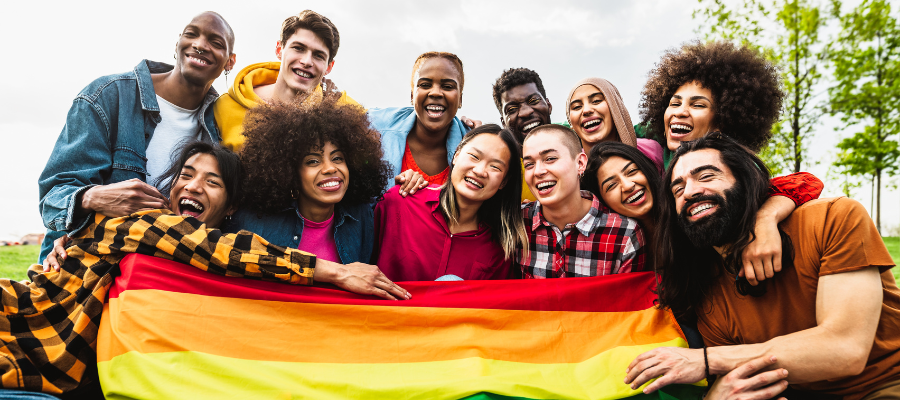From Rainbow Washing to Solidarity: How to Create an LGBTQ+ Inclusive Brand

Celebrating Pride has become synonymous with the month of June. From parades to flags and apparel, many are content to visibly and vocally display their support for the LGBTQ+ community. Yet, there are dissenters. The political frenzy around this community has been divisive, resulting in brands that feel pressured to participate in Pride for fear of being labeled out of touch or not participating to avoid backlash.Â
The reality is that 7.2% of U.S. adults identify as LGBTQ+, representing over $1 trillion in spending power, and this number is expected to grow as younger demographics age. And despite the recent backlash against Bud Light, Target, and others, consumer sentiment toward the LGBTQ+ community is slowly changing. New research shows that 88% of non-LGBTQ+ individuals are either positive or neutral in their feelings towards companies or brands celebrating Pride in their marketing or advertising.
While consumer sentiment is changing toward Pride Month celebrations and the LGBTQ+ community, some organizations still struggle with marketing to this group. Here are a few common pitfalls.
Peeling Off Rainbow Stickers: Rainbow WashingÂ
“Rainbow Washing” may be a new term to some and familiar to others. It refers to brands that ride the rainbow bandwagon during Pride Month only to sideline LGBTQ+ support for the rest of the year. Conservative estimates suggest LGBTQ+ spending power in the U.S. is the fastest-growing minority segment at $1.4 trillion yearly. Globally, by 2050, the Pride population is set to hit to one billion mark. That’s a billion people, not just potential customers, yearning for real support and connection. To truly make a difference, brands must move beyond performative gestures and strive toward tangible, year-round support.
Deconstructing Symbolism: The Journey Towards True LGBTQ+ Allyship
Performative allyship, such as temporarily changing a logo to rainbow colors or selecting a single spokesperson to represent an entire community, can be more damaging than helpful, especially if support for LGBTQ+ individuals doesn’t show up in the organization day to day. Surprisingly, despite the visible support from various companies during Pride Month, nearly half of LGBTQ+ individuals say they remain closeted at work, exposing a stark disparity between symbols and reality.
To counter this discrepancy, businesses can take tangible steps:Â
- Nurture diverse talent poolsÂ
- Elevate LGBTQ+ leaders within organizationsÂ
- Form alliances with LGBTQ+ organizationsÂ
- Integrate LGBTQ+ individuals organically and authentically into marketing campaigns throughout the year, reflecting their presence in everyday contexts.Â
Microsoft is a prime example of this kind of active allyship. Their diversity-promoting policies and protection for gender and sexual minorities have earned them a perfect score on the Human Rights Campaign’s Corporate Equality Index for over a decade.
So take a deep dive into your organization to see how it’s showing up in support of this community. This self-assessment gives you a baseline of where you are in your level of support to reveal growth opportunities. Â
Bridging the Marketing Gap: Giving The LGBTQ+ Community a Voice Â
Traditional marketing strategies often overlook the diverse voices within this community, leading to data that doesn’t accurately represent this demographic. Societal pressures and fear of discrimination can further silence these voices. Yet, when we genuinely engage with the LGBTQ+ community, the results can be phenomenal. Consider XBox’s “pride controller” campaign that included more than 30 LGBTQIA+ interwoven community flags that celebrate intersectionality and unity.
In SummaryÂ
Businesses need to ensure that their advocacy for gender and sexual minorities extends beyond just Pride Month and is woven into their core values and marketing strategies. The essence of brand activism lies in maintaining an authentic, ongoing dialogue with the LGBTQ+ community, manifesting itself in actions that resonate throughout the year. As RuPaul wisely said, “Life is about using the whole box of crayons.” Therefore, a brand’s commitment to diversity and inclusion should reflect the entire spectrum of these crayons, presenting genuine, year-round support.




![[Guest Post] Why Visual Graphics Will Help Your Content Be Seen‬](https://crayonsandmarketers.com/wp-content/uploads/2016/06/BenefitsOfVisuals_graphic-1-768x341.jpg)
